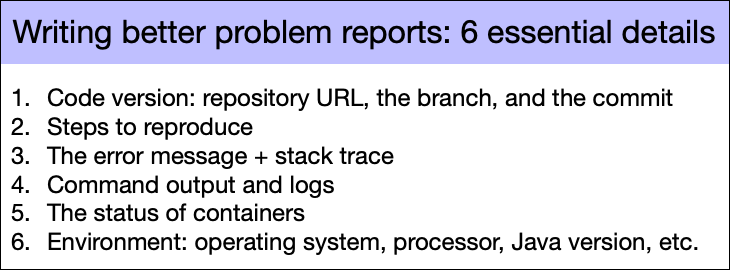Writing better problem reports: 6 essential details
Contact me for information about consulting and training at your company.
The MEAP for Microservices Patterns 2nd edition is now available
Let’s imagine that you have just cloned an application’s Github repository and have encountered a problem. For example, perhaps ./gradlew build is failing. Or, perhaps one of the application’s containers is failing to start. You need to ask for help. But what information should you include in the problem report?
In this post, I’ll answer that question from the perspective of a recipient of problem reports from users of a variety of platforms and applications including the Eventuate platform and platform.microservices.io. Many problem reports are quite thorough but sadly there are some that are remarkably vague. As a result, it can be difficult to diagnose the root cause.
To avoid any confusion, here are the details that I generally like to see in a problem report.

Git repository and commit + any changes that you have made
The first essential detail is the version of the code that you are attempting to use. The commit might seem obvious, especially if you have created a GitHub issue. But, new commits might have been added since you cloned the repository. Or, the repository might have multiple branches or tags. What’s more, you might report the problem outside of the repository, such as via Email or Slack. Consequently, your problem report should include the repository URL, the branch, and the commit.
Furthermore, if you have made changes to the code you should also describe them in your problem report.
A good way to describe the changes is to provide the output of git diff, e.g. git diff origin/master.
Steps to reproduce
The second essential detail to include in the problem report is the sequence of ‘commands’ that reproduce the problem. You might need to also describe how you ran the command(s). For example, Gradle tasks can be run from either the command line or within Intellij IDEA.
The error message + stack trace
Another essential detail is the complete error message that has been copy/pasted from the terminal window or test report. Also, if it’s a Java application, you should provide the complete stack trace (which includes the error message) since it will show the error’s location.
Logs
It’s also essential to include the output of the failing command and/or any log files. For example:
- Output of the command copy/pasted from the terminal window or from the test report
- If the application is containerized, container logs
- Other logs, such as a server log
In order to ensure that you don’t leave out any important details, you should provide the complete log files and test report files. One convenient way to do do this is by creating Github Gists.
The status of containers
If the application is containerized, it’s valuable to include the output of docker ps -a.
With the -a option, docker ps shows all containers, not just running containers.
Quite often a terminated container is a valuable clue.
Environment
Lastly, it’s important to describe your environment, which includes:
- Operating system, e.g. Windows, Mac, Linux
- Processor, e.g. Macs now come in two flavors, Intel and ARM
- Java version, e.g. the output of
java -version - Versions of other relevant tools, e.g.
docker versionanddocker-compose version
You could, for example, include the output of uname -a.
Summary
Please include the following essential details in your problem reports:
- Code version: repository URL, the branch, and the commit + any changes that you have made
- Steps to reproduce
- The error message + stack trace
- Command output and logs
- The status of containers
- Environment: operating system, processor, Java version, etc.


 Premium content now available for paid subscribers at
Premium content now available for paid subscribers at 




